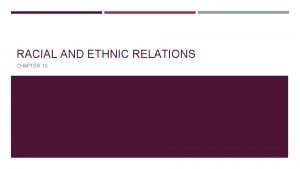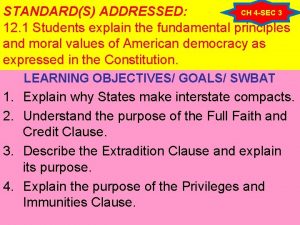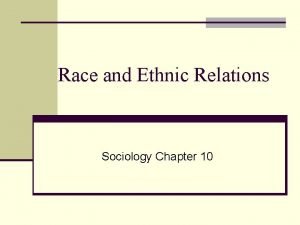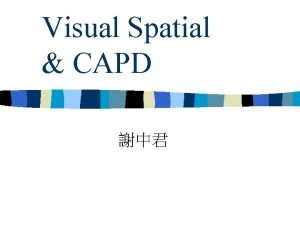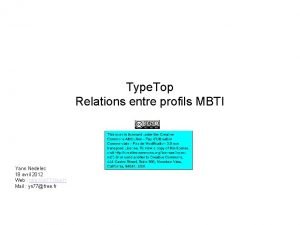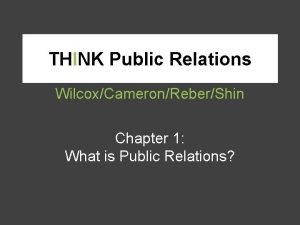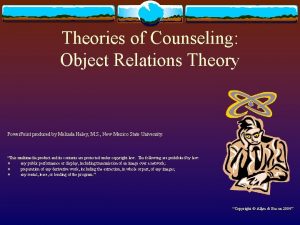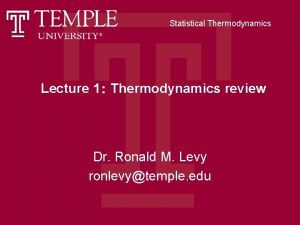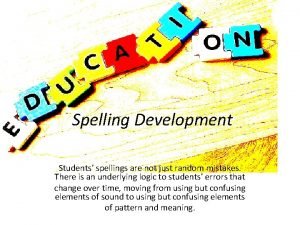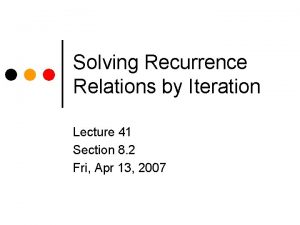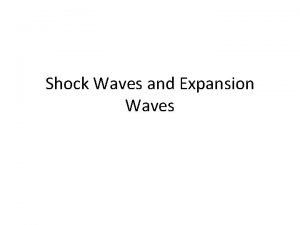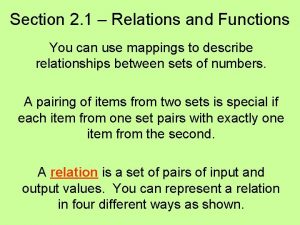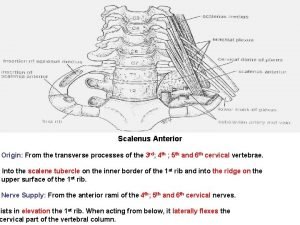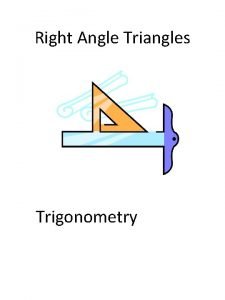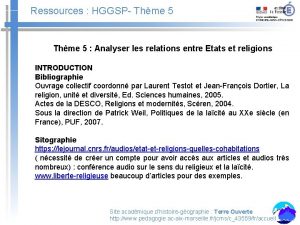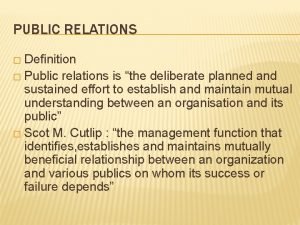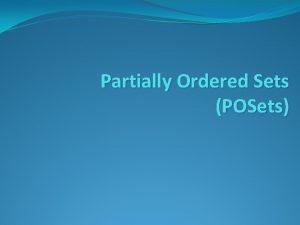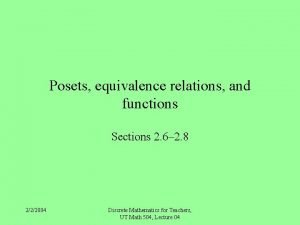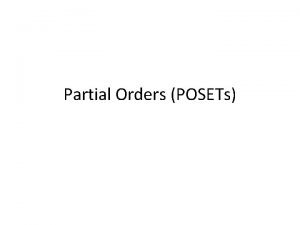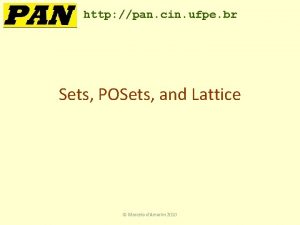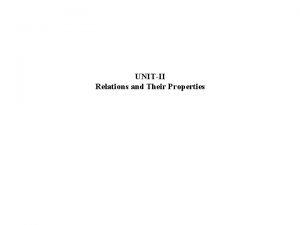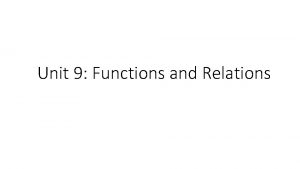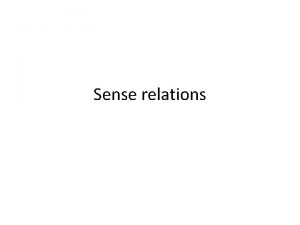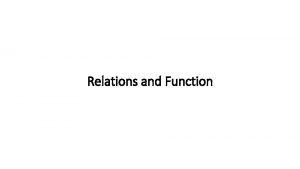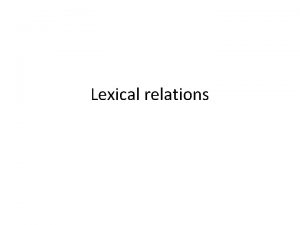Relations Chapter 6 5 6 6 Posets 6





























![Equivalence Class (2) • The elements in [a]R are called representatives of the equivalence Equivalence Class (2) • The elements in [a]R are called representatives of the equivalence](https://slidetodoc.com/presentation_image_h/03e1a9dfce5362f6529c700c7e1ea308/image-30.jpg)
![Equivalence Class (3) • We will prove that [a] = [b] by showing that Equivalence Class (3) • We will prove that [a] = [b] by showing that](https://slidetodoc.com/presentation_image_h/03e1a9dfce5362f6529c700c7e1ea308/image-31.jpg)
![Equivalence Class (4) • (2) (3): [a] = [b] [a] [b] – Let a, Equivalence Class (4) • (2) (3): [a] = [b] [a] [b] – Let a,](https://slidetodoc.com/presentation_image_h/03e1a9dfce5362f6529c700c7e1ea308/image-32.jpg)
![Equivalence Class (5) • (3) (1): [a] [b] (a, b) R. – Let c Equivalence Class (5) • (3) (1): [a] [b] (a, b) R. – Let c](https://slidetodoc.com/presentation_image_h/03e1a9dfce5362f6529c700c7e1ea308/image-33.jpg)




- Slides: 37

Relations (Chapter 6. 5 – 6. 6)

Posets (6. 5) • Definition: A set A (domain) together with a partial order relation R is called a partial ordered set or poset and is denoted by (A, R). • Example: Suppose R is the relation `divides’. We can show that (N, R) ((N, |)) is a poset. • We often use the symbol for a partial order.


Comparability and total orders of a poset (S, R) • Definition: The elements a and b of a poset (S, R) are called comparable if either (a, b) R or (b, a) R. Note that both cannot belong to R since R is antisymmetric. When a and b are elements that neither (a, b) R nor (b, a) R, a and b are called incomparable. • Example: Consider the poset (Z, R) where Z is the set of integers and R indicates the relationship `divide’. – 3 and 6 are comparable – 3 and 5 are not comparable.

Comparability and total orders of a poset (S, R) • Definition: If (S, R) is a poset, and every two elements a and b of S are comparable, (S, R) is called a totally ordered set, and R is called a total order. • Example: (Z, ≤) is a totally ordered set.

Partial order defined on a power set.

Hasse Diagram to represent posets.

Hasse Diagram to represent posets.

Hasse Diagram Example

Hasse Diagram Example

Hasse Diagram Example



Partial order defined on a power set. Greatest element Least element


An application

An application

An application

An application

Practice problems: • Show that (P(A), ) is a poset. Draw the Hasse diagram of (P({a, b, c}, ). Determine the greatest and the least elements of the poset. • Suppose R is defined as: R = {(a, b) | a, b Z and a+b is even}. – Is (Z, R) a poset? • Consider the `divides’ relation on the set A = (1, 2, 23, …. , 2 n}. 1. Prove that this relation is a total order on A. 2. Draw the Hasse diagram for this relation when n=3.

Equivalence Relation (6. 6) • Consider the set of people • Now consider a R relation such that (a, b) R if a and b are siblings. • Clearly this relation is – Reflexive – Symmetric, and – Transitive • Such as relation is called an equivalence relation • Definition: A relation on a set A (domain) is an equivalence relation if it is reflexive, symmetric, and transitive

Equivalence relation example

Equivalence Relations: Example 1 • Example: Let R={ (a, b) | a, b R and a b} – Is R reflexive? – Is it transitive? – Is it symmetric? No, it is not. 4 is related to 5 (4 5) but 5 is not related to 4 Thus R is not an equivalence relation

Equivalence Class (1) • Definition: Let R be an equivalence relation on a set A and let a A. The set of all elements in A that are related to a is called the equivalence class of a. We denote this set [a]R or just [a] if it is clear what R is. [a]R = { s | (a, s) R, s A}


Equivalence Relations: Example 2 • Example: Let R={ (a, b) | a, b Z and a=b} – Is R reflexive? – Is it transitive? – Is it symmetric? – What are the equivalence classes that partition Z?

Equivalence Relations: Example 3 • Example: For (x, y), (u, v) R 2, we define R={ ((x, y), (u, v)) | (x 2+y 2=u 2+v 2} • Show that R is an equivalence relation. • What are the equivalence classes that R defines (i. e. , what are the partitions of R 2)?

Equivalence Relations: Example 3 • Example: For (x, y), (u, v) R 2, we define R={ ((x, y), (u, v)) | x 2+y 2=u 2+v 2} Two points are related if they lie on a circle with the center at the origin. • Show that R is an equivalence relation. • What are the equivalence classes that R defines (i. e. , what are the partitions of R 2)? (concentric circles with the center at the origin)

Equivalence relation on set A={-1, 1, 2, 3, 4}
![Equivalence Class 2 The elements in aR are called representatives of the equivalence Equivalence Class (2) • The elements in [a]R are called representatives of the equivalence](https://slidetodoc.com/presentation_image_h/03e1a9dfce5362f6529c700c7e1ea308/image-30.jpg)
Equivalence Class (2) • The elements in [a]R are called representatives of the equivalence class • Theorem: Let R be an equivalence class on a set A. The following statements are equivalent 1. a. Rb (i. e. (a, b) R) 2. [a]=[b] 3. [a] [b] • Proof: We first show that (1) (2)
![Equivalence Class 3 We will prove that a b by showing that Equivalence Class (3) • We will prove that [a] = [b] by showing that](https://slidetodoc.com/presentation_image_h/03e1a9dfce5362f6529c700c7e1ea308/image-31.jpg)
Equivalence Class (3) • We will prove that [a] = [b] by showing that [a] [b] and [b] [a]. – – – – – Suppose c [a]. Thus (a, c) R. Because (a, b) R, and R is symmetric, therefore (b, a) R. Thus (b, a) R and (a, c) R, and R is transitive, therefore (b, c) R. Because of the symmetric property of R, (c, b) R as well. This implies that c [b]. Therefore [a] [b]. The proof for [b] [a] is similar. Hence [a] = [b].
![Equivalence Class 4 2 3 a b a b Let a Equivalence Class (4) • (2) (3): [a] = [b] [a] [b] – Let a,](https://slidetodoc.com/presentation_image_h/03e1a9dfce5362f6529c700c7e1ea308/image-32.jpg)
Equivalence Class (4) • (2) (3): [a] = [b] [a] [b] – Let a, b A such that [a] = [b]. Since a [a], we know that it also belongs to [b]. – This means that a [a] [b]. – This implies [a] [b]
![Equivalence Class 5 3 1 a b a b R Let c Equivalence Class (5) • (3) (1): [a] [b] (a, b) R. – Let c](https://slidetodoc.com/presentation_image_h/03e1a9dfce5362f6529c700c7e1ea308/image-33.jpg)
Equivalence Class (5) • (3) (1): [a] [b] (a, b) R. – Let c [a] [b]. c exists since [a] [b] is non-empty. – Therefore, c [a] and c [b] Since a [a], we know that it also belongs to [b]. – Thus (c, a) R and (c, b) R. – R is symmetry: (a, c) R and (b, c) R. – R is transitive: (a, b) R.

Partitions (1) • Equivalence classes partition the set A into disjoint, non-empty subsets A 1, A 2, …, Ak • A partition of a set A satisfies the properties – ki=1 Ai=A – Ai Aj = for i j – Ai for all i

Partitions (2) • Example: Let R be a relation such that (a, b) R if a and b live in the same province/ territories , then R is an equivalence relation that partitions the set of people who live in Canada into 13 equivalence classes

Partitions (2) • Theorem: – Let R be an equivalence relation on a set S. Then the equivalence classes of R form a partition of S. – Conversely, given a partition Ai of the set S, there is a equivalence relation R that has the set Ai as its equivalence classes.

Partitions: Visual Interpretation • Example: Let A={1, 2, 3, 4, 5, 6, 7} and R be an equivalence relation that partitions A into A 1={1, 2}, A 2={3, 4, 5, 6} and A 3={7} – Draw the 0 -1 matrix – Draw the digraph
 Employee relations in public relations
Employee relations in public relations Timid bigot example
Timid bigot example Chapter 10 racial and ethnic relations
Chapter 10 racial and ethnic relations Privileges and immunities clause examples
Privileges and immunities clause examples Interstate relations chapter 4 section 3
Interstate relations chapter 4 section 3 Chapter 10 racial and ethnic relations review worksheet
Chapter 10 racial and ethnic relations review worksheet Derivational relations stage
Derivational relations stage Visual spatial relations
Visual spatial relations Relation mbti
Relation mbti Think public relations
Think public relations Clients often criticize public relations firms for:
Clients often criticize public relations firms for: Theories of pr
Theories of pr Object relations theory - ppt
Object relations theory - ppt Nadir of race relations
Nadir of race relations Components of trachea
Components of trachea Federal service labor management relations statute
Federal service labor management relations statute Human relations media
Human relations media Walt disney company investor relations
Walt disney company investor relations Telenor investor relations
Telenor investor relations Thermodynamic potentials
Thermodynamic potentials Derivational relations stage
Derivational relations stage Derivational relations stage
Derivational relations stage Solve the recurrence relation
Solve the recurrence relation Linear homogeneous recurrence
Linear homogeneous recurrence Social thinking social influence social relations
Social thinking social influence social relations Shock wave definition
Shock wave definition Member collection in semantics
Member collection in semantics Relations and functions
Relations and functions Origin of scalenus anterior
Origin of scalenus anterior Metric relations in a right triangle
Metric relations in a right triangle Bibliographie hggsp terminale
Bibliographie hggsp terminale Combining relation
Combining relation The expression is a
The expression is a Realist theory of international relations
Realist theory of international relations Puget sound energy investor relations
Puget sound energy investor relations Public relations types
Public relations types Pr research process
Pr research process Public relations deliberate planned
Public relations deliberate planned

